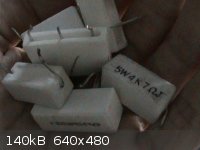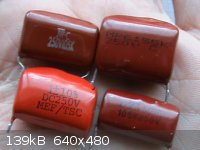99chemicals
Hazard to Others
  
Posts: 174
Registered: 24-3-2012
Location: In the Octet
Member Is Offline
Mood: No Mood
|
|
Reclaiming Chemicals from Electronic Components
I have a large stash of circuit boards from everything that I have taken apart in the last 5 years.
I am wondering if there are any usefull chemicals that can be gotten from certain PCB mounted components like resistors, capacitors, MOVs, or other
various components.
(I know about palladium from monolithic ceramic caps. That has been discussed and I am not asking about it. I am not asking about gold refining!)
I am wondering what the resistive material in resistors is. I have some large ceramic 5w ceramic resistors pictured below.

I also have a handful of these red capacitors pictured below. Does anybody know what chemicals are inside one of them? I accidently broke one of
the leads of one when removing from a board the inside looked metallic. What type of capacitor are these?

Any help would be appreciated.
|
|
|
Rogeryermaw
National Hazard
   
Posts: 656
Registered: 18-8-2010
Member Is Offline
Mood: No Mood
|
|
the red caps may be tantalum. it is very commonly used in capacitors and has quite interesting properties.
http://en.wikipedia.org/wiki/Tantalum
|
|
|
phlogiston
International Hazard
    
Posts: 1376
Registered: 26-4-2008
Location: Neon Thorium Erbium Lanthanum Neodymium Sulphur
Member Is Offline
Mood: pyrophoric
|
|
Some types of resistors do contain interesting elements, but in tiny quantities.
The following quote is from wikipedia, on thin/thick film resistors:
| Quote: | | The type of material is also usually different consisting of one or more ceramic (cermet) conductors such as tantalum nitride (TaN), ruthenium oxide
(RuO2), lead oxide (PbO), bismuth ruthenate (Bi2Ru2O7), nickel chromium (NiCr), or bismuth iridate (Bi2Ir2O7). |
Open one of yours up to see how they are constructed.
-----
"If a rocket goes up, who cares where it comes down, that's not my concern said Wernher von Braun" - Tom Lehrer |
|
|
Twospoons
International Hazard
    
Posts: 1282
Registered: 26-7-2004
Location: Middle Earth
Member Is Offline
Mood: A trace of hope...
|
|
The resistors: most likely contain Nichrome wire or film, that value could also be carbon film .
The capacitors are not tantalum. They look like a plastic film capacitor, most likely metalised polyester (aluminium and PET).
Helicopter: "helico" -> spiral, "pter" -> with wings
|
|
|
woelen
Super Administrator
        
Posts: 7977
Registered: 20-8-2005
Location: Netherlands
Member Is Offline
Mood: interested
|
|
Tantalum capacitors look different, they have the shape of a raindrop with two little legs. Tantalum capacitors have high capacity for small volume
and have low leakage, but they are only available for the lower voltage ratings (at most a few tens of volts, but many of them have a voltage rating
less than 10 V).
|
|
|
froot
Hazard to Others
  
Posts: 347
Registered: 23-10-2003
Location: South Africa
Member Is Offline
Mood: refluxed
|
|
Those resistors are the higher wattage pc board mount type, from my experience they are either resistive wire or carbon film type. I'm not aware of
any interesting elements in them.
The caps in the photo look like what we call polypropylene capacitors or 'polyprops'. As mentioned they are a roll of dielectric with a metal film,
most likely aluminium film.
We salute the improvement of the human genome by honoring those who remove themselves from it.
Of necessity, this honor is generally bestowed posthumously. - www.darwinawards.com |
|
|
Arthur Dent
National Hazard
   
Posts: 553
Registered: 22-10-2010
Member Is Offline
Mood: entropic
|
|
The most interesting components are found on vintage electronics boards. Especially semiconductors! Old diodes, transistors and ICs often have a
thicker gold plating than recent semiconductors, Tantalum caps are easy to spot but it's a mess to try to extract the tantalum from them.
It especially applies to computers, the older they are, the more gold there is in them, in particular the processor and the connector edges. A quick
visit inside derelict computers can often get you 3 or 4 components that contain most of the precious metals in the whole thing.
More recent components like SMDs can be scraped-off boards with a chisel, then crushed to a fine dust, and chemically dissolved to extract the
goodies. I rememeber there was a thread on how to salvage valuable metals from electronic components a while ago.
Robert
--- Art is making something out of nothing and selling it. - Frank Zappa ---
|
|
|